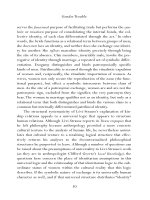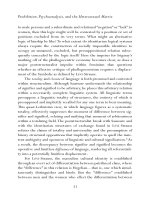GENDER TROUBLE 143
Bạn đang xem bản rút gọn của tài liệu. Xem và tải ngay bản đầy đủ của tài liệu tại đây (20.29 KB, 1 trang )
Gender Trouble
the girl-child, the result is melancholy for both, for the separation is
never fully completed.
As opposed to grief or mourning, in which separation is recognized and the libido attached to the original object is successfully displaced onto a new substitute object, melancholy designates a failure to
grieve in which the loss is simply internalized and, in that sense,
refused. Instead of a negative attachment to the body, the maternal body
is internalized as a negation, so that the girl’s identity becomes itself a
kind of loss, a characteristic privation or lack.
The alleged psychosis of homosexuality, then, consists in its thorough break with the paternal law and with the grounding of the female
“ego,” tenuous though it may be, in the melancholic response to separation from the maternal body. Hence, according to Kristeva, female
homosexuality is the emergence of psychosis into culture:
The homosexual-maternal facet is a whirl of words, a complete
absence of meaning and seeing; it is feeling, displacement, rhythm,
sound, flashes, and fantasied clinging to the maternal body as a
screen against the plunge . . . for woman, a paradise lost but seemingly close at hand.10
For women, however, this homosexuality is manifest in poetic language which becomes, in fact, the only form of the semiotic, besides
childbirth, which can be sustained within the terms of the Symbolic.
For Kristeva, then, overt homosexuality cannot be a culturally sustainable activity, for it would constitute a breaking of the incest taboo in an
unmediated way. And yet why is this the case?
Kristeva accepts the assumption that culture is equivalent to the
Symbolic, that the Symbolic is fully subsumed under the “Law of the
Father,” and that the only modes of nonpsychotic activity are those
which participate in the Symbolic to some extent. Her strategic task,
then, is neither to replace the Symbolic with the semiotic nor to
establish the semiotic as a rival cultural possibility, but rather to validate those experiences within the Symbolic that permit a manifesta108









